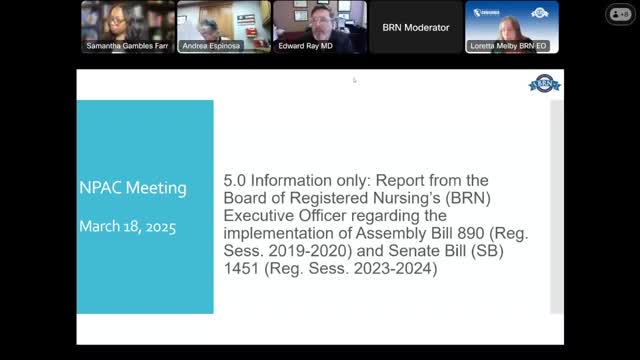California updates NP 103 regulations allowing broader practice areas for nurse practitioners
March 19, 2025 | Respiratory Care Board of California, Boards and Commissions, Executive, California
Thanks to Scribe from Workplace AI and Family Portal , all articles about California are free for you to enjoy throughout 2025!

This article was created by AI using a video recording of the meeting. It summarizes the key points discussed, but for full details and context, please refer to the video of the full meeting. Link to Full Meeting
One of the most notable updates is the removal of the requirement that the attesting provider must be in the same specialty as the NP completing their transition to practice hours. Previously, a pediatric nurse practitioner, for example, was required to complete their transition hours in a pediatric setting and have a pediatrician attest to their experience. This restriction has been lifted, allowing NPs to gain experience in any practice area, which could potentially lead to a broader range of practice opportunities.
However, this change has raised concerns among committee members regarding the implications for patient care and the integrity of NP practice. Some members expressed worries that the new regulations might dilute the original intent of the law, which was to enhance access to primary care, particularly in underserved areas. The discussion highlighted fears that the changes could lead to an increase in specialty practice rather than addressing the pressing need for primary care providers.
The committee clarified that while the NP 103 can practice in various settings, they must do so within a group practice environment and under the supervision of at least one physician. This stipulation aims to ensure that NPs maintain a level of competency and oversight, although some members questioned whether this would adequately protect public safety, especially if NPs begin to practice in areas outside their formal training.
The meeting also touched on the NP 104 classification, which maintains stricter requirements, including that practitioners must work within their area of education and national certification. This distinction is crucial as it ensures that NPs practicing independently are doing so in alignment with their training, thereby safeguarding patient care.
In conclusion, the updates discussed during the meeting reflect a significant shift in the regulatory landscape for nurse practitioners in California. While the changes aim to provide greater flexibility and accessibility in NP practice, they also raise important questions about the balance between expanding practice opportunities and ensuring patient safety. The BRN's role in implementing these changes will be critical as the healthcare community navigates the implications of these new regulations. Further discussions and regulatory updates are anticipated as stakeholders continue to assess the impact of these changes on healthcare delivery in the state.
Converted from Board of Registered Nursing’s Nurse Practitioner Advisory Committee Meeting - March 18, 2025 meeting on March 19, 2025
Link to Full Meeting
Comments
View full meeting
This article is based on a recent meeting—watch the full video and explore the complete transcript for deeper insights into the discussion.
View full meeting
